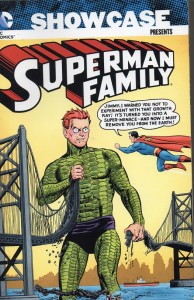Comic Book Review: Showcase Presents: Superman Family Volume 4 edited by Mort Weisenger
Lois Lane and Jimmy Olsen are two of the most enduring characters in comic books, thanks to being attached to the one and only Superman. Lois appeared in the first Superman story in Action Comics #1 (1938), a snarky but skilled reporter who initially had little use for Clark Kent but admired the mysterious superhero. Jimmy appeared first in the radio adaptation in 1940, first as a copy boy and then as a cub reporter/photographer, being brought into the comics proper in 1941.
As popular supporting characters, they appeared often in Superman’s stories. In the 1950s, they got their own continuing series, Superman’s Pal, Jimmy Olsen and Superman’s Girlfriend, Lois Lane. As you can tell by the titles, Superman was the co-star of each of these series, appearing in every story. Eventually, the series, along with Supergirl and some other Superman-related characters, were merged into an anthology comic titled Superman Family.
Jimmy’s stories often centered around him suddenly gaining a superpower, a special advantage, or undergoing a weird transformation. He would figure out some way of using this, until he got cocky and needed Superman to bail him out of the resulting trouble. Other stories revolved around his falling in love with women who almost invariably weren’t going to stick around. His most frequent love interest was Lucy Lane, Lois’ little sister, who was much less invested in the relationship than he was.
Jimmy had an ultrasonic signal watch which he could use to summon Superman in case of trouble, though the watch itself often caused trouble, or Jimmy would misuse it.
Lois also got temporary superpowers often, but her stories focused much more on her relationship with Superman. She often tried to trick him into marrying her or discover his secret identity. She also met quite a few men that were ready to marry her right away, though all of them turned out to be flawed in one way or another. Often Lois was pitted against Lana Lang, Clark Kent’s childhood friend as fierce rivals and best friends.
Sadly, the period where Lois initially got her own series was also when she reached the nadir of her characterization. Back in the Golden Age, she’d been independent and often gotten herself out of fixes before Superman could rescue her. Her personality hadn’t revolved around her love of Superman nearly as much either. Early Silver Age Lois was too often a “damsel in distress” and came off shrewish. (She remained a crackerjack reporter, though. Half of the danger she got in was because of her successful investigative journalism.)
It’s no wonder that Superman often played mean pranks on Jimmy and Lois to teach them a lesson. Sadly, those lessons never stuck.
It is important to remember that these stories (this volume covers 1960-61) were aimed at children, who were expected to only read comics for a few years. Thus plotlines were often recycled as the previous readers weren’t going to notice, and the status quo remained as steady as possible so that the experience was consistent no matter how many issues you might have missed. They were never meant to be read all in a row by adults.
Some standout stories in this volume include “Jimmy’s Gorilla Identity” which has an appearance by Congo Bill and Congorilla (Bill, a “great white hunter” , could swap minds with a golden gorilla); “The Curse of Lena Thorul” the first appearance of Lena, who was Lex Luthor’s long-lost sister (and later became one of Supergirl’s supporting cast); and several “Imaginary Stories” peeking into possible futures where Lois Lane and Superman finally get married.
Supergirl and Krypto also pop up a few times; as this was during the period when Supergirl was Superman’s “secret weapon”, she has to be careful that neither Lois or Jimmy realize what’s going on or who she is.
There is period sexism (a couple of stories mention that married women are discriminated against in the job market), hussy-shaming (“slut” was a word you couldn’t use under the Comics Code), fat-shaming, and a general attitude of lookism even by the good guy characters.
All that said, these are fun stories with inventive ideas, often having more plot packed into eight pages than many modern superhero comics do in eight issues. Highly recommended for the nostalgic Superman fan, moderately recommended for other fans (check your local library.)


This post was worth reading for the word Congorilla alone! 😀
I have never read the Superman comics, but am fascinated by the way that comic books have reflected society over the decades. I’m particularly interested in women’s roles in comics.
When you refer to Golden Age Lois — the stronger, independent incarnation of her character — which years/decades are being referenced? I’m curious if Golden Age Lois maps out to the strength that women allowed themselves to express during World War II.
Golden Age Lois was approximately 1938-1948 or so. Part of her “chickification” seems to be the same wave of “back to the home” movement that was happening to women in gerneral after WWII (the returning GIs needed those jobs!) And part seems to have been National Comics (the people who would become DC) deciding to focus the majority of their marketing on a target audience of 8-12 year old boys. Boys who very much felt threatened by the concept of independent, non-submissive women.